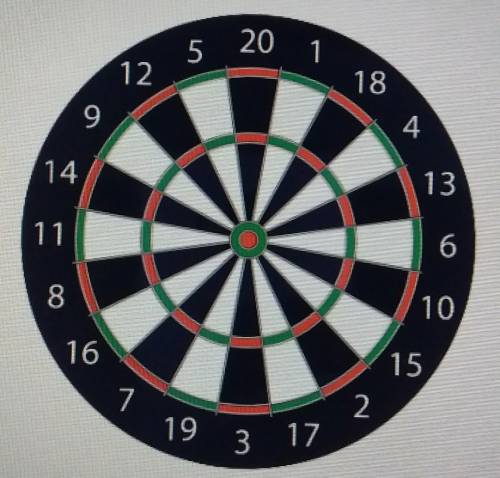The inner red dot is called the double bull's-eye, and its outer edge is 0.5 inch from the
cent...

Mathematics, 26.05.2020 20:59 school4life110
The inner red dot is called the double bull's-eye, and its outer edge is 0.5 inch from the
center. The green ring around the double bull's-eye is called the bull's-eye, and its outer
edge is 1 inch from the center. The inner red and green ring is the triple score ring. This
ring is 0.5 inches wide, and its outside edge is 5 inches from the center. The outer red
and green ring is the double score ring. This ring is 0.5 inches wide, and its outside edge is 8 inches from the center. The double score ring is the outer edge of the scoring area. Use this information to answer the questions that follow.
A. What is the exact area of the total scoring portion of the board?
B. What is the area of the board inside the triple score ring, including the ring?
C. What is the area of the board inside the triple score ring, not including the ring?
D. Based on your answer for part b and c, what is the area of the triple score ring?


Answers: 3


Another question on Mathematics

Mathematics, 21.06.2019 12:50
4. a spring scale is constructed so that each 0.10-n increment is separated by 0.50 cm. what spring constant is necessary for the scale to be accurate? -1.0n/cm -0.10n/cm -9.8 n/cm -0.20n/cm
Answers: 3

Mathematics, 21.06.2019 17:30
Monthly water bills for a city have a mean of $108.43 and a standard deviation of $32.09. find the probability that a randomly selected bill will have an amount greater than $155, which the city believes might indicate that someone is wasting water. would a bill that size be considered unusual?
Answers: 1

Mathematics, 21.06.2019 21:30
Mis the midpoint of rq if rm equals 2x + 5 and mq equals 4x - 9 what is the length of rq
Answers: 1

Mathematics, 21.06.2019 23:00
Each of the following data sets has a mean of x = 10. (i) 8 9 10 11 12 (ii) 7 9 10 11 13 (iii) 7 8 10 12 13 (a) without doing any computations, order the data sets according to increasing value of standard deviations. (i), (iii), (ii) (ii), (i), (iii) (iii), (i), (ii) (iii), (ii), (i) (i), (ii), (iii) (ii), (iii), (i) (b) why do you expect the difference in standard deviations between data sets (i) and (ii) to be greater than the difference in standard deviations between data sets (ii) and (iii)? hint: consider how much the data in the respective sets differ from the mean. the data change between data sets (i) and (ii) increased the squared difference îł(x - x)2 by more than data sets (ii) and (iii). the data change between data sets (ii) and (iii) increased the squared difference îł(x - x)2 by more than data sets (i) and (ii). the data change between data sets (i) and (ii) decreased the squared difference îł(x - x)2 by more than data sets (ii) and (iii). none of the above
Answers: 2
You know the right answer?
Questions

English, 02.11.2019 00:31


Mathematics, 02.11.2019 00:31


Chemistry, 02.11.2019 00:31







English, 02.11.2019 00:31



Biology, 02.11.2019 00:31

Mathematics, 02.11.2019 00:31


Social Studies, 02.11.2019 00:31




